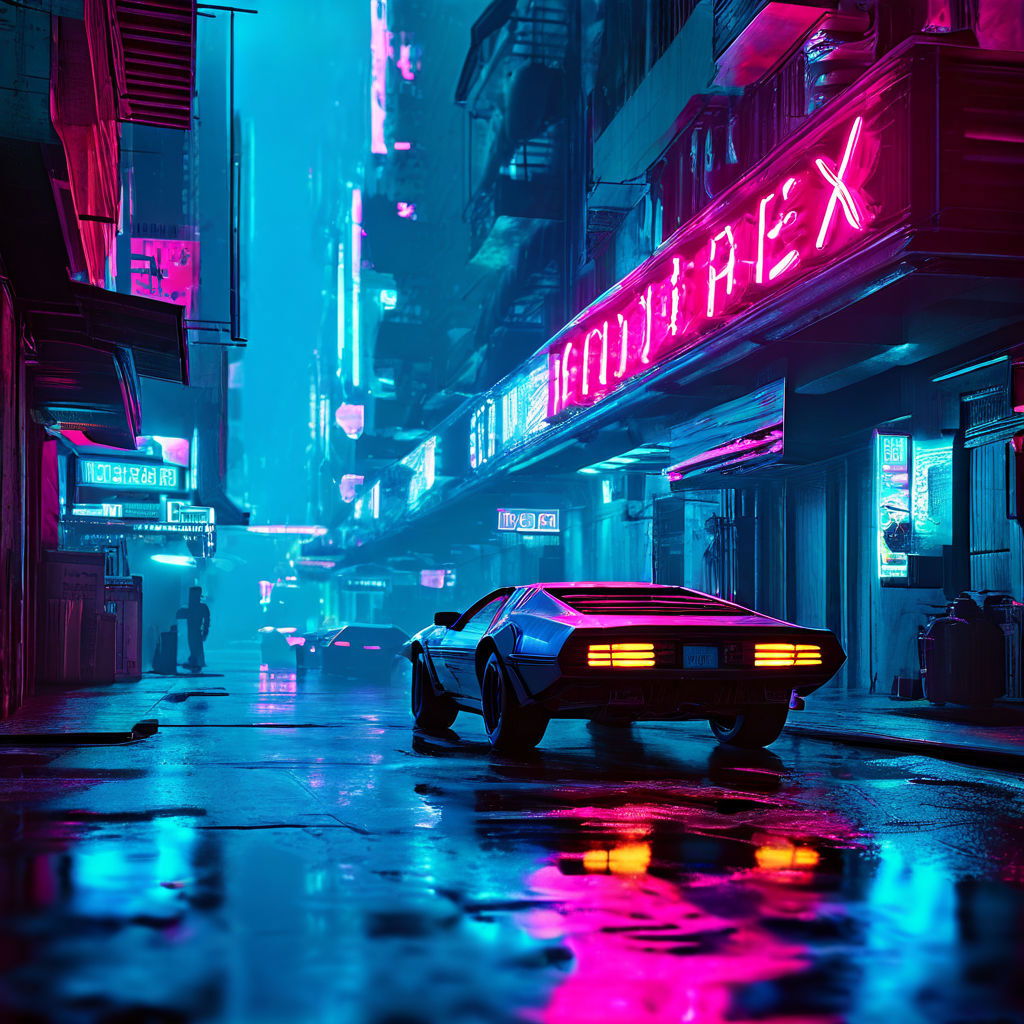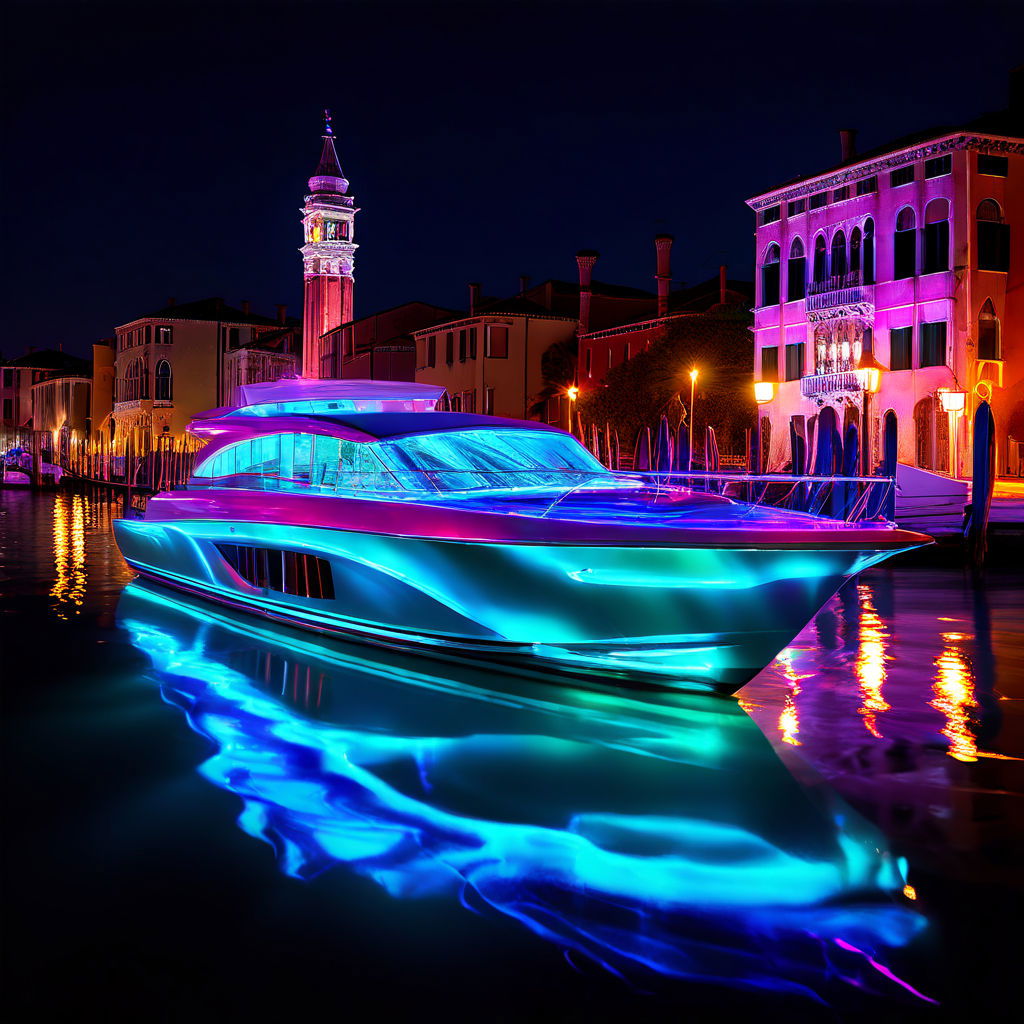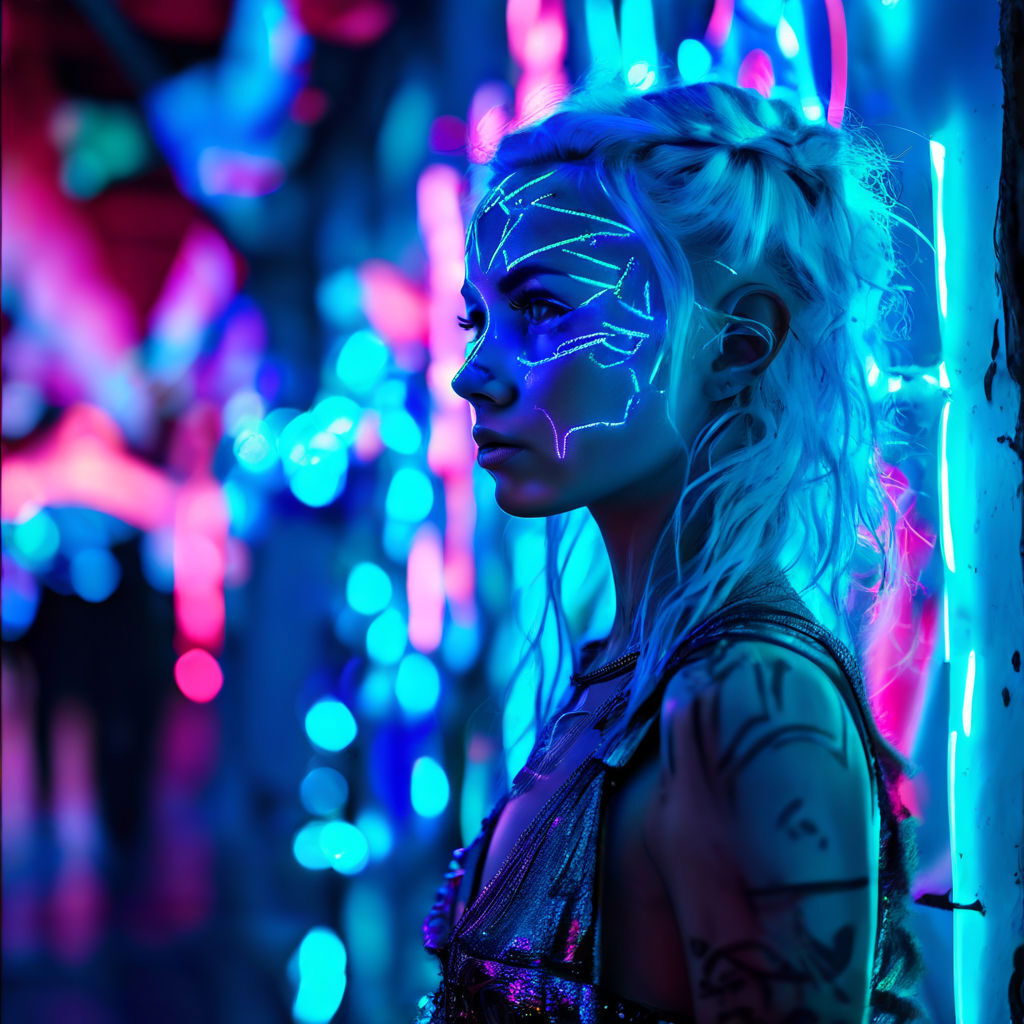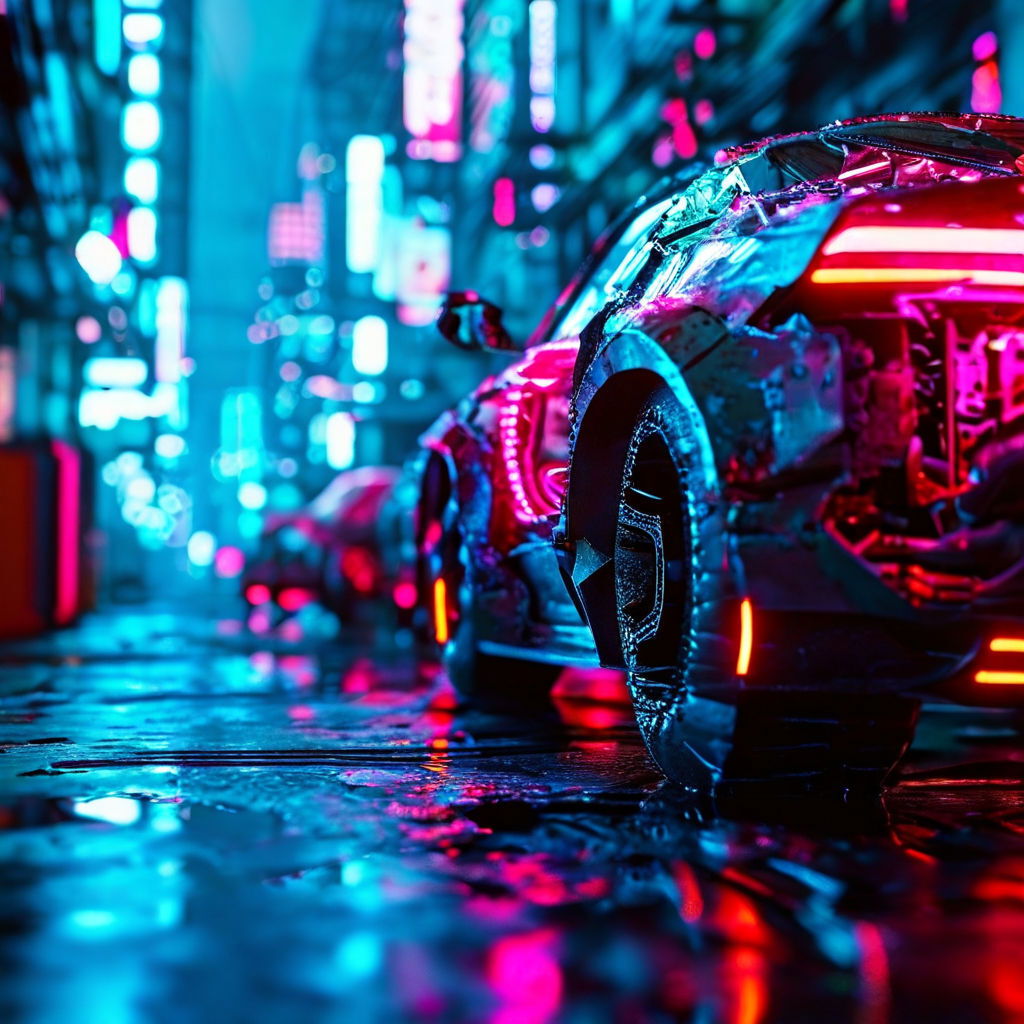neon short stories
Illuminating the Shadows: Holographic Neon in Cyberpunk Aesthetics

In the sprawling urban landscapes of cyberpunk fiction, neon isn't just a flourish of color—it's a narrative device that tells stories of disparity, progress, and decay. The genre, known for its focus on a dystopian future shaped by advanced technology and corporate dominance, uses neon and holographic imagery not only to create its signature visual style but also to delve deep into societal critiques. This article explores how the glowing allure of holographic neon serves both aesthetic and thematic roles in cyberpunk universes.
At its core, cyberpunk is a genre of contrast. Beneath the glossy surface of high technology, there's often a dark undercurrent of human struggle and systemic neglect. Neon lights, in this context, act as visual metaphors. They illuminate the night skies of cyberpunk cities, casting long shadows and highlighting the stark differences between the life of the technological elite and the plight of the disenfranchised. In movies like Blade Runner and Ghost in the Shell, neon is ubiquitous, bathing futuristic cities in a spectral glow that feels both alien and intimately familiar.
The use of neon in these settings goes beyond mere decoration. It underscores the juxtaposition of wealth and poverty, of the synthetic and the organic. It reflects a world where the artificial brightness cannot fully penetrate the pervasive darkness of societal issues. This imagery invites viewers to reflect on the dualities of progress—where light does not necessarily denote hope, and where shadows are not always devoid of life.
The integration of holographic technology in cyberpunk visuals adds another layer to this complex aesthetic. Holograms in these narratives often serve as both functional and decorative elements, from floating advertisements to interactive interfaces that appear at a street corner or in the dingy back alleys of a mega-city. These holographic elements extend the narrative space, offering a 3D canvas that brings the cyberpunk city to life.
Holographic neon in cyberpunk is more than eye candy; it often plays a critical role in the storyline. In Altered Carbon, holograms are not just futuristic billboards but are integrated into the very essence of daily life, representing both the pinnacle of consumer technology and a means of social control. Here, holography is a tool used by the powerful to shape perceptions and control the masses, illustrating the genre's frequent critique of power dynamics.
The choice of neon colors is also significant in establishing the mood of cyberpunk settings. Bright pinks, deep blues, and vibrant greens are commonly used to evoke a sense of otherworldliness. These colors, when cast in neon, create a surreal landscape that feels both inviting and dangerous. The psychological impact of these colors enhances emotional engagement, making the cyberpunk world palpable and immersive.
The neon aesthetic of cyberpunk does not merely serve to beautify; it encapsulates the essence of the genre. It reflects the futuristic yet grim realities of its narratives, where technology's bright promise is shadowed by the darker aspects of human nature and societal structures.
In cyberpunk, holographic neon is not just a background element but a dynamic character in its own right. It illuminates the highs and lows of futuristic societies, offering a vivid tableau that engages viewers both visually and intellectually. As cyberpunk continues to evolve as a genre, its neon-lit essence remains a powerful tool for storytelling, one that lights up the dark corners of its worlds with both brilliance and purpose.
--
From Blade Runner to Altered Carbon: The Evolution of Neon Holographics in Cyberpunk Media

Cyberpunk, a genre that seamlessly weaves the gritty with the technologically sublime, has long used neon and holographics to paint its visions of the future. This visual motif not only defines the aesthetic of the genre but also evolves with it, reflecting technological and artistic shifts over time. From the rain-soaked streets of Blade Runner to the digitally drenched skies of Altered Carbon, this article explores how neon holographics have grown from atmospheric elements to integral plot devices in cyberpunk media.
The release of Ridley Scott’s Blade Runner in 1982 marked a seminal moment in the visual storytelling of cyberpunk. The film’s use of neon-lit signage amidst a perpetually dark, dystopian Los Angeles served as more than just futuristic scenery; it was a narrative tool that underscored the fusion of East and West, the commercialization of urban spaces, and the alienation of the individual. Neon in Blade Runner was not just light; it was a symbol of both technological allure and decay, setting a standard for cyberpunk aesthetics.
As computer-generated imagery (CGI) became more sophisticated and accessible in the 1990s and early 2000s, so too did the capabilities to enhance cyberpunk's signature look. Films like The Matrix trilogy pushed this further, integrating neon not only as a physical part of the cityscape but as a vital component of the story's digital reality. Neon and holographics began to represent the blurring lines between real and virtual, questioning the nature of reality itself—a central theme in cyberpunk.
By the time Altered Carbon debuted on Netflix in 2018, holographic technology had become an advanced storytelling element in cyberpunk. The series used holograms not merely as urban decoration but as deeply integrated aspects of daily life and social interaction. Holographics in Altered Carbon were used to explore themes of identity, privacy, and transhumanism, reflecting how far the technology—and the genre’s treatment of it—had come. Here, holograms are pervasive and intrusive, capable of altering one's perception of space and self, echoing contemporary concerns about digital privacy and artificial intelligence.
The evolution of neon holographics is perhaps most interactive in video games. Titles like Cyberpunk 2077 allow players to navigate through a world where neon and holograms are not only visually immersive but interactable. These games offer a dynamic exploration of the cyberpunk universe, where players can experience firsthand the impact of these technologies on social and personal levels. The integration of holographics in gameplay mechanics also mirrors advances in real-world augmented reality, blurring the lines between game environments and potential future realities.
The progression from Blade Runner’s analog neon signs to the complex digital holographics of Altered Carbon and Cyberpunk 2077 showcases not only technological advancements but a deepening of the narrative capabilities of cyberpunk media. As new technologies emerge, the portrayal of neon and holographics in cyberpunk will likely continue to evolve, offering new ways to visualize and tell stories about our potential future societies. This continual innovation ensures that neon will remain a vibrant and critical element of cyberpunk’s visual and thematic lexicon, illuminating the shadows of human and technological interdependence.
--
NEON SHORT STORIES BY TEGEDAO:
Neon Renaissance: Venice Illuminated

In the neon-lit canals of Venice, the city had transformed. The Renaissance's charm was preserved in the architecture and art, yet it was revolutionized by the infusion of clockwork and neon technology, a spectacle of gear-driven innovation and vibrant light. The iconic palazzos and bridges were illuminated by intricate neon installations, casting reflections on the water that danced with the passage of every high-tech yacht.
Giovanni Bellini, a descendant of the famous painter and now a master clockmaker, had just completed his latest creation: a yacht named La Luminosa. Unlike any other vessel on the water, La Luminosa was adorned with holographic neon sails that shimmered with the histories of Venice, animated scenes of Doges and battles, festivities and the quiet everyday life of the past.
On its maiden voyage, Giovanni invited the city’s most distinguished scientists and artists. As the yacht glided silently through the Grand Canal, the guests marveled at the holographic displays. The neon blues, purples, and greens painted the night, while the gears beneath them hummed a tune reminiscent of a quieter, older Venice.
Among the guests was Isabella, a young inventor fascinated by the integration of neon tech with classical art. She approached Giovanni by the starboard rail, her eyes reflecting the neon glow."Signore Bellini, your yacht merges past and future. But tell me, do you not fear that these lights might overshadow the beauty of our history?" she asked, her voice tinged with both awe and concern.
Giovanni smiled, understanding her trepidation. "Isabella, I see these lights as beacons of our ingenuity. They do not obscure our history; they highlight our progress, our capacity to adapt and innovate. Just as our ancestors did with canvas and chisel, we do with gears and light."
As they conversed, the yacht passed beneath the Rialto Bridge, now a stunning display of moving gears and flowing neon, creating an illusion of the bridge perpetually rebuilding itself. It was here that Giovanni planned the highlight of the evening. He gestured for Isabella and the others to watch the sails as he adjusted a small, intricate device in his hand.
The holograms on the sails shifted, the historical scenes fading into a live painting session. The sails became a canvas where the movements of the guests were traced by neon lines, creating a dynamic artwork crafted by their own interactions. Laughter and applause broke out as everyone recognized themselves in strokes of neon light, their movements creating evolving art.
"See, Isabella," Giovanni continued as he joined her to watch the spectacle, "our memories, our identities, they are etched in light and motion. We are not replacing history; we are continuing its narrative in new and unimaginable ways."
Isabella nodded, her initial skepticism giving way to admiration. She realized that this fusion of old and new did not compete; instead, it enriched, offering a fresh lens through which to view their heritage.
As La Luminosa returned to its mooring, the holographic art faded slowly, leaving a lasting impression on the guests. Venice, a city renowned for its preservation of history, now also glowed as a beacon of futuristic innovation. In this neon reflection, Giovanni and Isabella saw a path forward, one where light did not cast shadows but offered illumination, guiding the city into another era of renaissance—a renaissance of light, gears, and boundless creativity.
--
The Neon Elves of Alfheim:

In the celestial reaches of Yggdrasil, the world tree, there exists a city of such splendor that it seems a fragment of the heavens themselves. Alfheim, the abode of the elves, stretches vast and wondrous in the highest branches of the ancient tree, its existence a symphony of light and shadow. The elves of Alfheim, known as the Neon Elves, are beings of pure light energy, their forms shimmering with holographic hues that dance through the spectrum with every mood and thought.
The heart of Alfheim is its Central Spire, a towering structure of living Yggdrasil wood and glowing crystal, pulsing with the collective life force of the city. From here, the Neon King, Alaric, rules with a gentle hand, guiding his people in the arts of magic and light manipulation, ensuring their ancient knowledge is preserved amid the ever-changing glow of their radiant city.
On the eve of the Equinox Light Festival, a young elf named Lysandra discovered a strange darkness creeping along the fringes of Alfheim. This darkness, a cold void that absorbed light into itself, was unlike anything the elves had encountered. Alarmed, Lysandra reported her find to the Neon King.
King Alaric, with his deep understanding of light and its balance, was troubled. "This darkness," he murmured, adjusting the luminous fabric of his robe, "is not of our world. It comes from beyond Yggdrasil, from the spaces between the stars where light has yet to tread."
Determined to protect their home, Alaric and Lysandra prepared to confront this anomaly. They journeyed to the edge of Alfheim, where the branches of Yggdrasil twisted into the void of the cosmos. Here, the darkness was thicker, swallowing the lesser lights of the city.
Using a fragment of the Central Spire’s crystal, Alaric crafted two staves of light—weapons that could channel the Neon Elves' most powerful magic. Handing one to Lysandra, he instructed, "We must weave our light together, blend it into a spectrum that no darkness can resist."
Together, they cast streams of brilliant neon—reds, blues, greens, and violets spiraled into a radiant vortex. The darkness writhed against the onslaught but began to dissipate, unraveling under the weight of Alfheim’s pure light.
As the darkness faded, a starlit path appeared, leading into realms unknown. King Alaric looked to Lysandra, pride glowing in his eyes. "You have saved Alfheim, but this path suggests more realms need our light. Will you help me bring dawn to these dark places?"
Lysandra, her heart as bright as the stave in her hand, nodded. "I will follow this path wherever it leads, to ensure that no world lies in shadow for want of light."
Thus began the legend of the Neon Elves, not just as keepers of Alfheim, but as bringers of light to the darkest corners of the universe. Their story, woven into the fabric of Yggdrasil, shone as a beacon of hope—a testament to the power of unity and light over shadow.
And so, the Homeland of the Neon Elves became more than a city; it became a sanctuary of brightness, a place where light was not only celebrated but shared, forever illuminating the high branches of the world tree with the colors of possibility.
--
Neon Songlines: Paths of Light

In the neon-soaked future of Australia, the coastal megacities of Sydney and Melbourne had transformed into sprawling cyberpunk metropolises, connected by a glowing network of neon-lit highways. The cities, covered in holographic ads and cybernetic enhancements, were a far cry from the quiet darkness of the Outback. Yet, in this high-tech era, the ancient Aboriginal songlines — paths across the land followed by ancestral spirits — had not been forgotten. Instead, they had been woven into the very fabric of this new world.
Lara, a cultural anthropologist and tech developer, had dedicated her life to preserving these songlines through digital means. Using a groundbreaking technology called the Dreamweaver, she created an immersive virtual reality experience that allowed users to walk these sacred paths, experiencing the stories and songs of the Aboriginal ancestors in a full sensory holographic environment.
As Lara prepared for the launch of her Dreamweaver experience in Melbourne, she was approached by a mysterious figure — Tjukurpa, a revered Aboriginal elder whose name meant "dreamtime." Tjukurpa had heard of Lara’s project and wanted to ensure that it respected the deep spiritual significance of the songlines.
"The songlines are more than just paths across the land," Tjukurpa explained under the flickering neon of the city. "They are the heartbeat of our culture, the narrative of our existence."
Lara nodded, her mind racing with the possibilities. "I understand, Tjukurpa. I want to honor that. With your guidance, we can integrate the true essence of each songline into the virtual experience."
Impressed by her sincerity, Tjukurpa agreed, and together they traveled between Sydney and Melbourne, collecting stories, songs, and permissions from various Aboriginal communities. Lara's technology allowed them to record the elders' narrations and the ambient sounds of the landscapes, which were then artistically represented in the virtual environment.
As the project neared completion, Lara organized an event to unveil the Dreamweaver. The cities' neon glow served as a vibrant backdrop to the holographic displays that now pulsed with the ancient rhythms and colors of the Aboriginal songlines. People from all walks of life — city dwellers and visitors from remote communities alike — donned their VR headsets and stepped into a world where the past and future coexisted.
Walking the songlines virtually, they saw the neon contours of Sydney and Melbourne transform into the reds and oranges of the desert, the deep blues of the oceans, and the lush greens of the forest. Each step along the virtual songline revealed layers of stories, songs, and the spiritual connection of the land.
Tjukurpa, watching the awe on the faces of the participants, felt a deep sense of pride. Lara had succeeded not just in preserving the songlines but in breathing new life into them, bridging the gap between the ancient and the futuristic.
In this neon-drenched future, the songlines had found a new form of expression, ensuring that the Aboriginal heritage was not lost in the glittering lights of progress but was instead highlighted and revered. The Dreamweaver became a symbol of unity and respect, a meeting point of history and technology, proving that even in the most futuristic settings, the ancient songlines could still guide and illuminate the path forward.
--
NEON SHORT STORIES! CLOCKPUNK, ELFPUNK AND ISLANDPUNK!
--
The Science of Sight: How Cyberpunk’s Neon Holographics Influence Viewer Engagement
In the vivid world of cyberpunk, neon isn't just a stylistic choice—it's a sensory experience that taps into the very science of how we perceive and engage with visual media. This article explores how the intense and often otherworldly neon holographics of cyberpunk aesthetics not only define the genre but also deeply influence viewer engagement through visual perception, emotional response, and cognitive impact.
The human eye is naturally drawn to light, particularly in environments where contrast and color saturation play significant roles. Cyberpunk’s neon holographics make expert use of this instinct by employing highly saturated colors and stark contrasts that are rarely found in natural environments. This visual strategy ensures that elements within the scene are not only noticed but also remembered. Research in visual perception suggests that bright colors like those often used in neon lighting can create more vivid memories.This vividness is not just a byproduct of the genre's aesthetic but a deliberate technique to enhance viewer retention and engagement.
Neon colors in cyberpunk settings often convey mood and emotion, tapping into color psychology to evoke specific feelings. For example, cool blues and greens usually create a sense of calm or eeriness, while hot reds and oranges might signal danger or chaos. These colors do more than beautify the scene; they communicate the underlying themes of the narrative—often tension, disillusionment, and conflict—without a single word being spoken.
Moreover, the integration of holographic technology in storytelling adds an additional layer of interaction. These holograms can seem to reach out to the viewer, creating a sense of immersion and immediacy that flat images cannot achieve. The feeling of being "in the world" that holographics can induce is crucial for the deep emotional engagement necessary in compelling storytelling.
On a cognitive level, the use of neon and holographics in cyberpunk media can enhance the complexity and depth of the narrative. These elements often signify technological advancement and societal decay, prompting viewers to think critically about the implications of such technologies and their own world. This kind of environmental storytelling allows viewers to explore complex ideas like artificial intelligence, surveillance, and human enhancement through a highly engaging, visually stimulated framework.
Furthermore, the dynamic nature of holographic images, which can change and respond to narrative cues, encourages active cognitive participation. Viewers are not just passive recipients of information; they are active interpreters, constantly making sense of visual and narrative clues provided by the shifting holographic scenery.
The striking use of neon holographics in cyberpunk is more than just a hallmark of the genre’s aesthetic; it's a sophisticated blend of art and science designed to maximize viewer engagement. By understanding and manipulating how humans perceive and react to visual stimuli, cyberpunk creators can craft experiences that are not only visually arresting but also emotionally resonant and intellectually stimulating. This science of sight, when applied through cyberpunk’s distinctive neon hues and holographic contours, ensures that the genre remains as compelling to the senses as it is provocative to the mind.

--
Neon Noir : A Vice Miami Tale
In the neon-glowing metropolis of Vice Miami City, the skyline bled a spectrum of holographic neon colors, casting a surreal luminescence over the rain-slick streets. It was a city where the past collided with a futuristic cyberpunk vision, where the "Vice City Vibes" neon signs were not just advertisements but beacons calling to the souls of the city's inhabitants.
Jax, a nimble and shrewd street hustler, maneuvered his way through the crowded sidewalks where people and androids mingled indistinguishably. The air was thick with the scent of ionized rain and sizzling street food, punctuated by the electric hum of hovering vehicles overhead.
One evening, Jax's keen eyes caught a flicker of an unusually captivating holographic neon sign, "Vice City Vibes," shimmering in an array of impossible colors. Below it stood a classic car, a 1980s relic, juxtaposed against the modernity of its surroundings. It was said to belong to Vero, the notorious and enigmatic underworld figure rumored to control much of the city’s cybernetic trade.
Intrigued by the challenge and the thrill of the impossible, Jax devised a plan to steal Vero’s prized possession. The vehicle was not just a car but a symbol of power and defiance, outfitted with the latest anti-theft tech and guarded by both human and AI sentinels.
The night of the heist, Jax cloaked himself in a hacked invisibility jacket, its fibers shimmering with the same neon aesthetic that dominated the city. As he approached the vehicle, he deftly bypassed the biometric locks and disabled the surveillance drones with a device that fizzed with quiet electricity.
Sliding into the driver's seat, Jax couldn’t help but marvel at the interior, which blended retro chic with advanced tech, complete with a holographic dashboard that projected nostalgic 80s hits in vibrant laser lights. He fired up the engines, and the roar was a sweet symphony to his ears, a sound almost forgotten in the silent efficiency of modern vehicles.
As he drove through Vice Miami City, the neon signs blurred into streaks of light, creating a tunnel of colors around him. Every turn and acceleration was a step back in time, yet firmly rooted in the future. Jax felt a surge of adrenaline mixed with an odd sense of nostalgia, as if he were reclaiming a piece of history that was meant to be experienced, not just displayed.
But the thrill was short-lived. Vero had anticipated such a move and had been tracking the car's every move. The chase that ensued was less of a pursuit and more of a spectacle, with Jax maneuvering through impossible angles and shortcuts, only to be met by drones and cyber-enhanced thugs.
In a final gambit, Jax drove the car straight into the heart of the city’s largest digital plaza, where a massive display of holographic ads played. As he ejected from the car, it, along with the pursuing forces, became part of a colossal and explosive art installation, forever immortalized in neon and chrome.
Jax vanished into the neon-soaked night, his heart racing not from the loss, but from the sheer exhilaration of the ride. Vice Miami City, with its brilliant and dangerous charm, had won this round, but the game was far from over. In this city, every shadow and flicker of neon held a story, and Jax was ready to live them all.
--
This story is a cyberpunk futuristic tale because it blends advanced technology with a gritty urban environment, a hallmark of cyberpunk aesthetics. The narrative features elements like holographic neon lights, invisibility jackets, and high-tech vehicle security systems, set against the backdrop of a metropolis that merges the nostalgic vibe of the 80s with futuristic innovations. This juxtaposition of old and new, along with the integration of cybernetics and a society dominated by underworld figures and corporate power, embodies the core themes of cyberpunk, presenting a vision of a technologically advanced yet ethically complex future.

CYBERPUNK FUTURE!